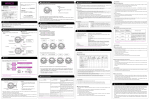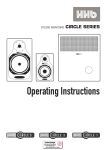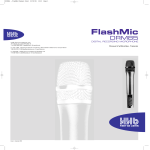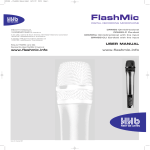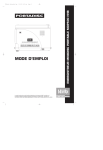Download Operating Instructions
Transcript
Studio Monitor Loudspeakers Operating Instructions Overview HHB Circle 5 loudspeakers are designed to produce an accurate and highly detailed sound, both on and off axis, making them ideal for use in stereo and surround sound professional monitoring applications. Available in active and passive versions, more than 20 years’ experience and a number of unique innovations have combined to produce a compact studio monitor capable of performing in the most demanding professional environments. Both versions of the Circle 5 feature a solid-state Polyswitch® that protects the tweeter from excessive input. Unlike other protection circuits which limit power to the tweeter, affecting the overall balance of the sound in a way which may not be immediately obvious to the listener, the Polyswitch® in the Circle 5 cuts all power to the tweeter and illuminates a red warning LED on the tweeter. After several minutes of cooling off, the switch auto-resets, having saved the tweeter from overload and subsequent damage. Key Features - Passive & Active • Detailed, accurate and dynamic sound, both on and off axis • Tight, controlled low-end performance • Accurate bass / treble driver time alignment • 200mm (8") bass/mid driver with a unique, injection moulded cone for increased dynamics and minimal bass colouration • Magnetically screened for use close to video / computer monitors • Individually tested and matched ferro-fluid cooled soft dome tweeter • Solid state, Polyswitch® tweeter overload protection • Rigid, non-resonant, seamless ported cabinet, finished in durable black paint • Many professional monitoring applications, including project studios, commercial studios, multimedia applications, broadcasting and post-production • Can be used as part of a surround sound monitoring system Key Features - Active Only • 120W LF / 70W HF integral amplifier pack • Balanced XLR and unbalanced RCA phono inputs • Push-Pull amplifier design for tight, controlled low-end performance • Extra-large toroidal transformer for added headroom and low hum field • Individually calibrated active filters • Low Q Sallen and Key active filters minimise mid-band peaks, resulting in a sound that doesn’t tire the listener, even after long periods • Long life smoothing capacitors • Massive heat sink for effective heat dissipation 2 Connecting The Speakers As part of a complete monitoring system, HHB Circle 5 studio monitor loudspeakers will deliver the clean, highly accurate sound required. Their wide, flat frequency response produces a reliable sound output, making the Circle 5 suitable for the highest quality audio monitoring applications. Circle 5 Passive Choosing an amplifier to match your speakers and application is important. The HHB Circle 5 requires connection to a power amplifier with a suggested output between 50 and 200 Watts RMS. The correct audio connection from amplifier to speaker should be made, otherwise damage to either could occur. This is made via a pair of binding posts on the rear of the loudspeaker. Take care to ensure that the positive (red +) terminal on the Circle 5 is connected to the positive (red +) terminal on the amplifier, and that the negative (black -) terminal on the Circle 5 is connected to the negative (black -) terminal on the amplifier. Connecting one of the loudspeakers out of phase will result in dramatic loss of low frequency signals and an incoherent spatial image. In stereo set-ups, ensure that the right hand speaker is connected to the right channel speaker terminals on the amplifier, and that the left hand speaker is connected to the left terminals. Always use good quality medium or heavy-duty speaker cable, not thin ‘bell’ wire. The main function of a speaker + – cable is to transfer the maximum amount of current with the minimum amount of distortion. It is therefore preferable to have a cable with a wide cross-sectional area, since this will reduce the electrical resistance. If the cable is too thin, the resistance rises and heating may occur. Also, try to keep the length of cable from the loudspeaker to the amplifier short to keep the induced noise as low as possible. Where possible, use the same length of cable for each speaker. 3 Circle 5 Active Audio connection to the active Circle 5 is via a balanced XLR or unbalanced RCA phono. The audio should be connected to either input, not both, with the input switch being set accordingly - pushed in for balanced XLR and out for unbalanced RCA phono. Power should be switched off when connecting or disconnecting any signal to or from the loudspeakers, or when changing the position of the selector switch, since the loudspeakers and internal amplifiers may be damaged. The active Circle 5 should be connected to a suitable mains power supply using the mains cable supplied. The mains input is via an IEC connector. The XLR input is wired as a differential input, as shown below, (viewed from the end of the male pins). Some older American pieces of equipment reverse the functions of pins 2 and 3, effectively phase reversing the signals. Pin Connection 1 2 3 Ground Live (Hot) Return (Cold) 3 2 1 When cable runs are long - about ten metres or more (approximately thirty feet) - or there is electromagnetic interference in the vicinity of the cable (from a motor, for instance), it is advisable to use balanced XLR cables so as to avoid any induced noise. 4 Positioning Your Loudspeakers Correct positioning of loudspeakers in the room is essential, as this will greatly affect the accuracy of the sound. Speakers radiate sound from all directions and therefore placing them against walls or on the floor is not advisable. HHB Circle 5 monitors are optimised for use under free-field conditions - therefore for the best results, consider the following points when setting up your speaker system. Speaker Placement • The Circle 5 loudspeakers should be placed upright on stands, away from boundaries to reduce reflections. Do not place them on their sides, as the response at the crossover frequency will be inaccurate. • Both speakers should be the same distance from the listening position. • The Circle 5 speakers should be angled in towards each other, so as to point at the listening position, and placed at a height where the listener’s ears are level with the tweeters. • Ideally, the two speakers should sit at the corners of a triangle, where the distance from position D to C is a little longer than the distance from A to B: Loudspeakers A D B C Listener • The listener should not sit too close to the speakers, (i.e., within this imaginary triangle), since the important centre image can be greatly affected when listening in this position. 5 Basic Surround Sound Speaker Location • Distance from the listening position to each of the loudspeakers should always be the same. If the listener is at the centre point of an imaginary circle, the speakers should all lie on the circle’s circumference. The Circle 1 active subwoofer will be available in early 1999 to complement the Circle 5 in surround sound applications. Effect Of The Room On Sound Quality • The Circle 5 loudspeakers should not be placed too close to the wall - less than one metre away (approximately three feet) - as this will augment the bass frequencies. At these low frequencies, the sound from the loudspeakers radiates in all directions, and reflects off any hard surfaces to combine with the direct sound. At higher frequencies, sound from the loudspeakers is more directional, causing less of a problem with interference. • Avoid positioning the loudspeakers in corners, since there may be unwanted interference patterns caused by the reflections of the signal from the walls, which will colour the low frequencies, giving the impression of extreme bass warmth. Effect Of Placing Speakers On Or Near The Mixing Console • Avoid placing the HHB Circle 5 studio monitors on top of a mixing console, since this will adversely affect the frequency response. Some of the sound output will reflect off the surface of the console, interfering with the direct sound from the loudspeakers. • Position the speakers on stands slightly behind and above the console. Ported Cabinets • Ported cabinets, if carefully designed, allow greater bass output. The HHB Circle 5’s port utilises the rear sound radiation of the bass unit effectively to augment bass response. • Damping inside the cabinet is critical with ported loudspeakers - too much damping will reduce the low frequency output and too little damping may result in a peak at the resonant frequency. The HHB Circle 5 studio monitors are designed with a flat frequency response from 48Hz up to 20kHz. 6 Warranty Information In order to register ownership it is essential that you complete and return the user registration card supplied with this product. All components used in HHB Circle 5 studio monitors are guaranteed against faulty materials or workmanship for a period of one year from the date of purchase. This warranty will become void if the product has been misused, modified or tampered with in any way. HHB shall not be liable for any consequential or incidental damages due to the failure of this product. In the unlikely event of a product failure please contact your local dealer. Fuse Replacement When replacing the fuse, only a 2A slow blow type which conforms to local safety regulations should be used. Safety Warning To prevent fire or electric shock hazard do not operate this equipment outside, or expose to rain or moisture. BEWARE - HHB Circle 5 studio monitors are capable of producing high sound pressure levels. Be careful not to monitor at high volumes for long periods as this may cause hearing damage. 7 Specifications Circle 5 Passive Transducer System . . . . . . . . . . . . . . . . . . . . . . . . . . . . . . . . . . . . . . . . . . . . . . . . Ported 2 way monitor loudspeaker. Drive Units . . . . . . . . . . . . . . . . LF: Custom 200mm (8") polymer cone, high compliance long throw rubber surround. 25mm (1") high temperature aluminium voice coil and shielding antimagnet. HF: Custom 28mm (1.1") ferro-fluid cooled soft dome with rear damping chamber. 28mm (1.1") high temperature aluminium voice coil and shielding antimagnet. Frequency Response . . . . . . . . . . . . . . . . . . . . 48Hz - 20kHz, +/- 3dB free space with very smooth off axis response. Sensitivity . . . . . . . . . . . . . . . . . . . . . . . . . . . . . . . . . . . . . . . . . . . . . . . . . . . . . . . . . . . . . . . . . . . . . . . . 87 dB 1W/1m. Suggested Amplifier Power . . . . . . . . . . . . . . . . . . . . . . . . . . . . . . . . . . . . . . . . . . . . . . . . . . . . . . . . . . . . . 50 - 200W. Impedance . . . . . . . . . . . . . . . . . . . . . . . . . . . . . . . . . . . . . . . . . . . . . . . . . . . . . . . . . . . . . . . . . . . . . 8 Ohms nominal. Power Handling (programme) . . . . . . . . . . . . . . . . . . . . . . . . . . . . . . . . . . . . . . . . . . . . . . . . . . . . . . . . . . . . . . . 120W. Crossover . . . . . . . . . . . Pro-grade components on double-sided fibreglass PCB, critically damped, 2.6kHz crossover. Connectors . . . . . . . . . . . . . . . . . . . . . . . . . . . . . . . . . . . . . . . . . . . . . . . . . . . . . . . . . . . . . . . . . . . . . . . Binding posts. Dimensions (HxWxD) . . . . . . . . . . . . . . . . . . . . . . . . . . . . . . . . . . . . 420mm x 255mm x 300mm / 16.5" x 10" x 11.8". Weight . . . . . . . . . . . . . . . . . . . . . . . . . . . . . . . . . 10kg (22lbs) each (net), 20.4kg (44.88lbs) packed in pairs (gross). Finish . . . . . . . . . . . . . . . . . . . . . . . . . . . . . . . . . . . . . . . . . . . . . . . . . . . . . . . . . . . . . . . . . . Durable black paint finish. Circle 5 Active As above, but with the addition of an internal power amplifier. Sensitivity For Full Output . . . . . . . . . . . . . . . . . . . . . . . . . . . . . . . . . . . . . . . . . . . . . . . . . . . . . . . . . . . . . . . . 1V RMS. Power (programme) . . . . . . . . . . . . . . . . . . . . . . . . . . . . . . . . . . . . . . . . . . . . . . . . . . . . . . . 140W Bass, 70W Tweeter. Active Crossover . . . . . . . . . . . . . . . . . . . . . . . . . . . . . . . . Crossover point at 2.6kHz. S&K active filters for LF and HF. Advanced design using ultra high precision components. Low noise audio ICs and 1% precision resistors used throughout. Power Amplifier . . . . . . . . . . . . . . . LF unit driven by twin power ICs in Push-Pull mode. HF unit driven by a single IC. Anti thump on/off circuitry. Regulated low noise, low distortion power supply with long life capacitors, guaranteeing full power over a long service life. Polyswitch® tweeter overload protection with LED indicator. Every module individually calibrated against reference for perfect stereo imaging. Connectors . . . . . . . . . . . . . . . . . . . . . . . . . . . . . . . . . . . . . . . . . . . . . . . . . . . . . . . . . . . Switchable XLR / RCA Phono. Weight . . . . . . . . . . . . . . . . . . . . . . . . . . . . . 12.6kg (27.72lbs) each (net), 25.6kg (56.32lbs) packed in pairs (gross). HHB Communications Ltd · 73-75 Scrubs Lane, London NW10 6QU, UK Tel: 020 8962 5000 · Fax: 020 8962 5050 · E-Mail: [email protected] HHB Communications USA LLC · 626 Santa Monica Boulevard, Suite 110, Santa Monica, California 90401, USA Tel: 310 319 1111 · Fax: 310 319 1311 · E-Mail: [email protected] HHB Communications Canada Ltd · 260 King Street East, Toronto, Ontario M5A 4L5, Canada Tel: 416 867 9000 · Fax: 416 867 1080 · E-mail: [email protected] Visit HHB on-line at: http://www.hhb.co.uk








